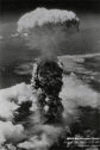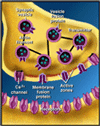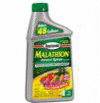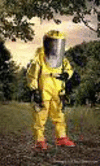 When I was a teenager in the sixties, some of my friends were lucky
enough to have fallout shelters; a perfect make-out spot right in their
own basement! Somehow, the government had people convinced that, in the
event of nuclear war, you could bundle the family down into a prepared
corner of the basement, eat dried beans and look at each other in an 8
by 10 foot room for a few years until the radiation all clear was
sounded by whoever-was-left-that-might-know, and then emerge to defend the American Way. As late as 1969, my high school health class
consisted of pithy lessons on what was safe to eat after the war (all I
remember is that beef with green stuff on it is ok if you trim off the
green...) and the effects of Beta and gamma radiation. Well, Physicians
for Social Responsibility finally named the lie of conventional
survivability (THE LIVING WILL ENVY THE DEAD). So did books like "A
Canticle For Leibowitz" and
When I was a teenager in the sixties, some of my friends were lucky
enough to have fallout shelters; a perfect make-out spot right in their
own basement! Somehow, the government had people convinced that, in the
event of nuclear war, you could bundle the family down into a prepared
corner of the basement, eat dried beans and look at each other in an 8
by 10 foot room for a few years until the radiation all clear was
sounded by whoever-was-left-that-might-know, and then emerge to defend the American Way. As late as 1969, my high school health class
consisted of pithy lessons on what was safe to eat after the war (all I
remember is that beef with green stuff on it is ok if you trim off the
green...) and the effects of Beta and gamma radiation. Well, Physicians
for Social Responsibility finally named the lie of conventional
survivability (THE LIVING WILL ENVY THE DEAD). So did books like "A
Canticle For Leibowitz" and  movies like “The Day After".
movies like “The Day After".
As near as I can figure, the government spends half their time scaring
us witless, and the other half telling us that if we do as instructed
we'll all be just fine. That routine is timeless; it’s like
ding-dong-ditch. That's why we get to take off our shoes at the
airport; it's the antidote for color-code-threat-level induced anxiety.
But this post isn’t about commercial aviation or government
manipulation of public mood; it’s about nerve gas.
Part I. A Brief Primer
Nerves talk to each other and muscles with many signaling chemicals,
chief among them acetylcholine, (Ach for short). The signaling nerve
releases Ach, which causes the "listening" cell on the receiving end to
 do its thing; contract (muscle) secrete snot (the lining of the nose), think
(brain cell) etc. It's the chemical "On" switch. AcH is an ancient
neurotransmitter, found in very primitive life forms,
and different AcH receptor types have evolved over time. As you read
this, stop for a moment and tap your finger on the table as fast as you
can. Not only must AcH act quickly, it better go away pretty quickly
too, or it’ll clog up the receptor sites at the listening (effector) cells;
otherwise, you tap once, you’re stuck. Evolution provides; AcH gets
almost instantly destroyed by acetylcholinesterase right at that
receptor site; acetylcholinesterase is an enzyme that lives to eat AcH;
It's the "off" switch.
do its thing; contract (muscle) secrete snot (the lining of the nose), think
(brain cell) etc. It's the chemical "On" switch. AcH is an ancient
neurotransmitter, found in very primitive life forms,
and different AcH receptor types have evolved over time. As you read
this, stop for a moment and tap your finger on the table as fast as you
can. Not only must AcH act quickly, it better go away pretty quickly
too, or it’ll clog up the receptor sites at the listening (effector) cells;
otherwise, you tap once, you’re stuck. Evolution provides; AcH gets
almost instantly destroyed by acetylcholinesterase right at that
receptor site; acetylcholinesterase is an enzyme that lives to eat AcH;
It's the "off" switch.
Now, deactivate the acetylcholinesterase and you get... chaos. Blue
screen crash. It’s the physiologic equivalent of an internet Denial of
Service attack; AcH mobbing receptors which fail under the load. It's
all "On" and no "Off." Muscles spasm and go flaccid. Seizures,
Diarrhea, salivation, Asthma. You die convulsing in your own effluvium.
Not pretty.
Anesthesiologists make part of their living gently tweaking
acetylcholine and its receptors. We use very weak drugs that
either block acetylcholinesterase or block the receptors for AcH
("competitive inhibition"). It’s a juggling act; the reward of doing it
right is we get to control lots of patient physiology. It’s a little
like being a pharmacologic puppetmaster. Very empowering. The price of
doing it wrong is inconvenient. The drugs and doses are so weak, that unless the
anesthesiologist is particularly inattentive, imbalances can be quickly
rectified. We use curare's descendants to intentionally paralyze muscles, and
we reverse the effect after a while with neostigmine which mildly deactivates
acetylcholinesterase and thereby pushes up AcH levels at that same
receptor, effectively shouting the "On" signal past the blocker.
Atropine does nothing at the muscle receptor, but blocks gut and heart
AcH receptors so that the AcH signal doesn't pass through.
Neostigmine is weak. Organophosphate insecticides
(malathion, others) do the same thing as neostigmine, only they are
eight hundred pound gorillas. They work as insecticides because insects
have  AcH receptors, just like we do. (Ancient, remember?) You get a
decent whiff of this stuff (or a little on your skin) and you get all
the above symptoms pretty quick. If you're lucky, they rush you to
hospital (assuming that the people trying to save you don't pick up a
dose through skin contact and join you in your throes) where the ER
staff washes you off and titrates doses of receptor blockers
(atropine), and administers anti seizure medications (valium and its
cousins). You will also be intubated and ventilated, since there is no suitable antidote for the muscle receptors. If they get it right and early, you might live, but you might have permanent damage to your
receptors or brain. It's not like "The Rock" where Nicolas Cage stabs
himself in the heart with antidote and saves San Francisco. (also,
nerve gas doesn't cause your flesh to melt; that was just to sell tickets)
Organophosphate insecticides are the sad method of choice for suicide amongst
debt-crushed Indian farmers.
AcH receptors, just like we do. (Ancient, remember?) You get a
decent whiff of this stuff (or a little on your skin) and you get all
the above symptoms pretty quick. If you're lucky, they rush you to
hospital (assuming that the people trying to save you don't pick up a
dose through skin contact and join you in your throes) where the ER
staff washes you off and titrates doses of receptor blockers
(atropine), and administers anti seizure medications (valium and its
cousins). You will also be intubated and ventilated, since there is no suitable antidote for the muscle receptors. If they get it right and early, you might live, but you might have permanent damage to your
receptors or brain. It's not like "The Rock" where Nicolas Cage stabs
himself in the heart with antidote and saves San Francisco. (also,
nerve gas doesn't cause your flesh to melt; that was just to sell tickets)
Organophosphate insecticides are the sad method of choice for suicide amongst
debt-crushed Indian farmers.
 Nerve gas does the same thing, only it's even more potent... It's like
human insecticide. Israelis keep rolls of duct tape and plastic
sheeting around in case of attack to seal off a room. This might work,
I suppose, if you are lucky and fast, and have some air tanks to
maintain positive pressure and an oxygen supply.
Nerve gas does the same thing, only it's even more potent... It's like
human insecticide. Israelis keep rolls of duct tape and plastic
sheeting around in case of attack to seal off a room. This might work,
I suppose, if you are lucky and fast, and have some air tanks to
maintain positive pressure and an oxygen supply.
The
military carries around atropine and pralidoxime injectors.
(pralidoxime re-activates acetylcholinesterase, although doubts have been cast on its efficacy) I don't really know if this actually works; data on
successful field resuscitation is scant; I'm not sure what they would do about seizures and paralysis.
Some nerve gas comes and goes fairly quickly in the environment; a week
or so (sarin or GB). Some is oily and hangs around like a booby trap (VX) for
weeks waiting for you to touch something and absorb it through your
skin; a hellish chemical minefield. Notice how infantry now always wears
gloves in combat field ops...
The truth is, it is hard to defend against this sort of thing. The Academy of
Science and Institute of Medicine have a most excellent review of nerve gas science online, if you're interested in more detail.
 Although
ER physicians will be first responders, I think it likely and
appropriate that anesthesiologists
participate in the response, since
we are most familiar with the clinical manipulation of AcH
receptor
physiology and airways. Once in my career I have been in the position of taking
care of a patient while I was protected only by a hospital provided gown, N95 mask
and plastic visor in a situation where the responding fire rescue team
felt the situation warranted full hazmat gear; that was a little scary (it turned out ok... so far). That's my way of
suggesting that you check out your hospitals' preparations for hazmat
and virulent infection patients before you need the gear.
Although
ER physicians will be first responders, I think it likely and
appropriate that anesthesiologists
participate in the response, since
we are most familiar with the clinical manipulation of AcH
receptor
physiology and airways. Once in my career I have been in the position of taking
care of a patient while I was protected only by a hospital provided gown, N95 mask
and plastic visor in a situation where the responding fire rescue team
felt the situation warranted full hazmat gear; that was a little scary (it turned out ok... so far). That's my way of
suggesting that you check out your hospitals' preparations for hazmat
and virulent infection patients before you need the gear.
As the title suggests, I'm a a tad skeptical about all this. I'm not sure we're not just building fallout shelters here. But in the
end, my anesthesia (and Boy Scout) nature gets the better of me, and I say "be prepared." Intellectualization is a powerful emotional defense. I even have a roll of duct tape...
 Mitch Keamy is an anesthesiologist in Las Vegas Nevada
Mitch Keamy is an anesthesiologist in Las Vegas Nevada
 Andy Kofke is a Professor of Neuro-anesthesiology and Critical Care at the University of Pennslvania
Andy Kofke is a Professor of Neuro-anesthesiology and Critical Care at the University of Pennslvania
 Mike O'Connor is Professor of Anesthesiology and Critical Care at the University of Chicago
Mike O'Connor is Professor of Anesthesiology and Critical Care at the University of Chicago
 Rob Dean is a cardiac anesthesiologist in Grand Rapids Michigan, with extensive experience in O.R. administration.
Rob Dean is a cardiac anesthesiologist in Grand Rapids Michigan, with extensive experience in O.R. administration.





